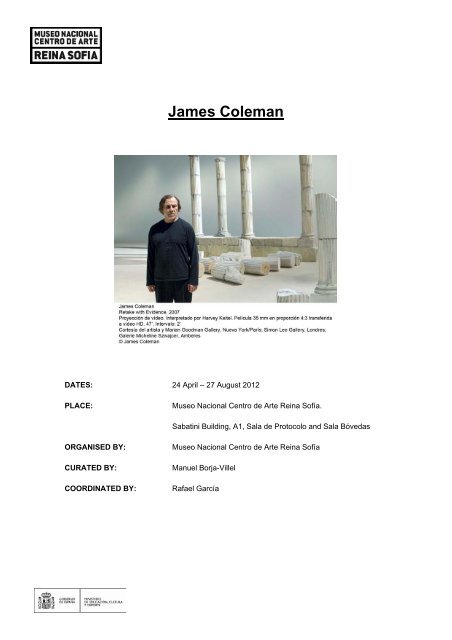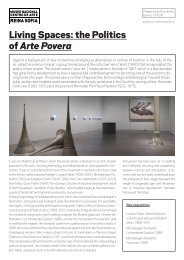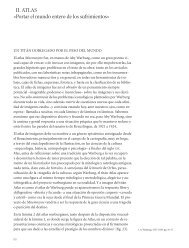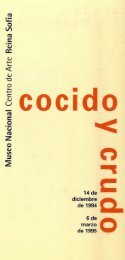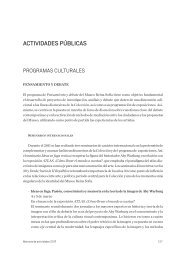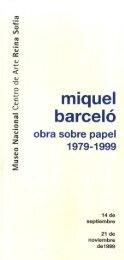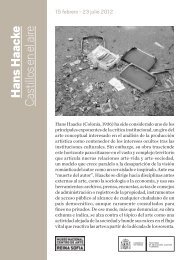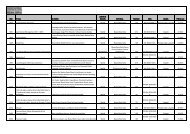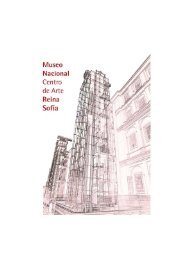You also want an ePaper? Increase the reach of your titles
YUMPU automatically turns print PDFs into web optimized ePapers that Google loves.
<strong>James</strong> <strong>Coleman</strong><br />
DATES: 24 April – 27 August 2012<br />
PLACE: <strong>Museo</strong> Nacional Centro de Arte <strong>Reina</strong> Sofía.<br />
Sabatini Building, A1, Sala de Protocolo and Sala Bóvedas<br />
ORGANISED BY: <strong>Museo</strong> Nacional Centro de Arte <strong>Reina</strong> Sofía<br />
CURATED BY: Manuel Borja-Villel<br />
COORDINATED BY: Rafael García
The work of <strong>James</strong> <strong>Coleman</strong> (Ireland, 1941) proposes a reflection on the construction<br />
and experience of reality and explores questions relating to perception, representation,<br />
memory and identity. Through his use of audiovisual media, <strong>Coleman</strong> situates the<br />
subject at the centre of his work inviting the viewer to consider how intrepretation<br />
shapes our understanding of what we see. The “photographic” (still and moving image)<br />
plays an essential role in these investigations, which are articulated and accompanied<br />
by a certain poetic hermeticism and meticulous use of language.<br />
Incorporating synchronized projections of slides, films, audio narrations and<br />
soundtracks, <strong>Coleman</strong> creates mise-en-scène with references taken from daily life,<br />
literature, painting, theatre and cinema. Proposing visual scenarios which remain open<br />
to interpretation (double images, repetitions, dissociation of image and text, different<br />
narrative rhythms and tempos, alternation of past and present) <strong>Coleman</strong>´s work solicits<br />
viewers to participate in the unfolding of meaning. This exhibition, the most<br />
comprehensive retrospective to be devoted to <strong>Coleman</strong>’s long and illustrious career,<br />
brings together a wide selection of his work that includes his early pieces from the<br />
1970s, his work of the '90s like Lapsus Exposure and I N I T I A L S, and important<br />
pieces like Fly, Box, Untitled: Philippe VACHER and Retake with Evidence. A special<br />
selection of material from his personal archives is also on view to the public for the first<br />
time.<br />
Early Films, 1967-1972<br />
This group of films made in Milan and Ireland between 1967 and 1972 makes it clear<br />
that from very early on, <strong>Coleman</strong>’s explorations on the properties of “the photographic”<br />
were going to constitute the allegorical basis for his analysis of the photographic image<br />
as a psychic and social staging of the self. In Pheasant, the interplay of photograph<br />
and moving image presents us with an irresolvable reality between “death” and “life”<br />
through the image of a pheasant posed to look as though it realizes it is being watched.<br />
In Clock, he films an alarm clock with its hands stopped at 7:22. The filmic time passes<br />
yet the hour remains motionless, which gives the image a certain similitude with a still
photograph. La Valle della Morte presents the first few frames of a film, with the title<br />
superimposed on a landscape. However, the view shown is not that of Death Valley<br />
(California-Nevada) but Monument Valley (Navajo Tribal Park, Utah-Arizona border),<br />
an icon of the Hollywood western. In Skull, the film restores an enigmatic appearance<br />
of life to a ram’s skull shown in isolation, subverting the fascinum attributed to the<br />
photographic gaze as that which petrifies life. In Work-Apron, a shot of a balcony in an<br />
Italian town assumes the character of a theatrical performance, reminding the viewer<br />
that the photographic or filmic image conceals the world behind the scenes.<br />
Clara and Dario, 1975 (Exhibited in the Sala de Protocolo, Sabatini Building)<br />
Clara and Dario is regarded as one of the artist’s key works because it develops the<br />
unique format which characterizes his later creations: the projection of slides with a<br />
recorded voiceover narrating a story of intersubjective relations. Two synchronized<br />
carrousels each project in continuous cycle a sequence of colour photographs of a<br />
face. On the left is the character Clara, and on the right, Dario. The alternate forward<br />
and backward movement of the images complements the play between the present<br />
and the past in the narration, a possible dialogue between two people who are<br />
indecisive about whether or not to go on a journey together to Lake Como, the place of<br />
their childhood. Meanwhile, a romance between two further characters, Elsa and<br />
Andrea, enters the picture, and the viewer becomes uncertain whether they refer to<br />
Clara and Dario’s adolescent identities or to childhood friends. Two narratives thus<br />
cross and fold over each other like a Moebius strip. Through the voiceover and the<br />
tender gazes of the projected faces, the viewer is taken on a journey to an experience<br />
where personal identity is seen as a process in continuous flux, not wholly owned by<br />
the self, but inseparable from its shared intimacy with others.<br />
Box (ahhareturnabout), 1977(Exhibited in the Sala de Bóvedas, Sabatini Building)<br />
This is one of the few works by <strong>Coleman</strong> based on documentary material, in this case<br />
footage from the legendary 1927 return match in Chicago between Gene Tunney and<br />
Jack Dempsey for the world heavyweight boxing title. It is also the work which<br />
implicates the body most intensely. A regular beat consisting of two components, a<br />
pulse and its reverberation resembling the systole and diastole of the human heart,<br />
takes almost violent hold of the visitor’s body and turns it into the resonating chamber
of the artwork. At regular intervals, the images flash for a few fractions of a second, so<br />
briefly that it is impossible to follow the progress of the fight. With the heartbeat, the<br />
pulse of the visitor’s own body and the staccato phrases that are heard, <strong>Coleman</strong><br />
orchestrates a link between the visitor and the visual and acoustic apparatus. Not only<br />
does this generate the work’s complex aesthetic configuration, in which subject,<br />
structure and effect are interwoven, but several temporal levels also intersect. The<br />
representation of a historic event and the presence of its perception become<br />
permeable to each other, as if the historic were not represented but present and at the<br />
same time suspended in the aesthetic experience, thus evoking a dialogue with Walter<br />
Benjamin’s concept of history and experience.<br />
Seeing for Oneself, 1987-1988<br />
The dramaturgical elements introduced into <strong>Coleman</strong>’s earlier performed works are<br />
here transformed into photographic tableaux vivants based on the visual codes of<br />
popular pictorial narratives, and presented as a slide projection synchronized with a<br />
recorded narration. Seeing for Oneself circulates around the paradoxes of the subject’s<br />
formation ensuing from its attempts to reconcile the “truth” of rationalist logic and the<br />
“sense” of the phenomenal body, social conformity and individual agency, the self and<br />
its representation.<br />
Charon (MIT Project), 1989<br />
The work owes its title to the fact that it was produced during an artist’s residency at<br />
the MIT List Visual Arts Center in Cambridge, Mass. It is a piece which combines and<br />
synthesizes all the aspects of his earlier work: the problem of perception; the<br />
dimensions of the psychological, the social, the cultural and the historic; dramatic and<br />
theatrical elements; and the search for the self and the impossibility of an irrefutable<br />
identity. It consists of a tape and slide projection arranged as a number of episodes.<br />
Each one begins with the description of a photographic image and the circumstances<br />
surrounding its creation. In one episode concerned with a ‘Frankenstein’ image, Franz<br />
Kafka is quoted: “…we photograph things in order to drive them out of our minds.”<br />
Here, the work takes on the meaning of depiction as exorcism. In another episode,<br />
portrayal can be interpreted as a means of manipulating reality. Over a projected
image of a bedside table in a hospital, an invisible subject ponders the possibility of<br />
escaping death by the appropriation of a photographic image. If, at the final moment, it<br />
is true that one’s whole life flashes before one’s eyes, this final moment also has its<br />
image of remembrance, and that image its image, making up an endless series of<br />
images. Death would thus be eternally postponed, and the image included in a lived<br />
reality as a means of staving off death: photography as an elixir of life.<br />
Untitled: Philippe VACHER, 1990<br />
This piece, produced in an operating theatre in a hospital, shows an actor, Philippe<br />
Vacher, falling forward onto a surgical cart, and then righting himself and turning<br />
towards the camera. One imagines the entire action would take about three seconds,<br />
but in fact it unfolds over seventeen minutes. Time seems dilated. Certain images<br />
appear to linger longer to determine whether this is an objective peculiarity or a<br />
subjective perception. A second manipulation of the footage teeters on the edge of<br />
perceptibility. Not at all evident at first, it only gradually becomes visible in time. Its first<br />
sign is that by about five minutes into the piece, the primary colors are muted and start<br />
fading as if the filmstock itself had aged. Through the use of a black and white negative<br />
and a second process of rephotography, <strong>Coleman</strong> gradually leaches the color from the<br />
film.<br />
Lapsus Exposure, 1992-1994<br />
The work evolves around a nineties pop group who have assembled under contract to<br />
record a new album and have a group photograph taken for the cover, Lapsus<br />
Exposure delves further into the philosophical and social implications of the<br />
reproductive image.<br />
I N I T I A L S, 1993-1994<br />
The clinical setting of this work, peopled by several characters, offers nothing that<br />
allows their relationships to be established with any certainty. They could be members<br />
of a family, hospital employees or even patients. In any case, there is a doubling<br />
amongst these potential roles. As the rooms in the hospital are painted and renovated,<br />
the occupants are also preparing, or “dressing up”, for an occasion, which may be the
performance of a play. However, interwoven with this reading is a parallel narrative that<br />
relates to the hospital’s earlier function, accentuating the sense that the past still<br />
haunts the present. The act of folding, which is alluded to visually as well as vocally,<br />
equates with the Deleuzian notion of enfolded multiple temporalities, for which the<br />
photograph becomes a primary metaphor.<br />
Photograph, 1998-1999<br />
The work consists primarily of projected photographs of a group of schoolchildren,<br />
predominantly girls, who are rehearsing a dance in costume. The projection is<br />
accompanied by a narration delivered by a young woman’s voice. Photograph unites<br />
theatricality with poetic rhythm, rhyme and content. This theorizing of the staging of<br />
subjectivity takes the relationship between words and images as the site where<br />
meaning is negociated between the semiotic “media”.<br />
Retake with Evidence, 2007<br />
Retake with Evidence, an allegory concerned with issues of judgement from the<br />
perspective of the “Western subject”, explores the origins of thought in Ancient Greece<br />
through its mythology and philosophy. The actor Harvey Keitel slowly makes his way<br />
through a sparse but dramatically lit set, reciting a text on guilt and governance,<br />
sightlessness and oblivion, retribution and beauty. The work shows that evidence is<br />
located at the nucleus of questions of representation. Evidence not only plays an<br />
important part visually in the setting of the piece, but also in its narration. Seeing the<br />
actor amid this scenery of broken Greek statuary and skulls brings Oedipus Rex to<br />
mind. Metaphors of vision and blindness make Sophocles’s play a tragedy of<br />
enlightenment that dramatizes the heroic attempts of reason to fix the identity of the<br />
subject.<br />
In addition to these works, the exhibition also includes Fly (1970), Connemara<br />
Landscape (1980) and Ligne de Foi (1991).<br />
The Early Films will be shown in different cycles during the exhibition.<br />
The following works will be shown over two separate periods:<br />
• First period, from 25 April to 18 June:Photograph, I N I T I A L S.<br />
• Second period, from 20 June to 27 August:Lapsus Exposure; Seeing for Oneself.
Biographical notes<br />
<strong>James</strong> <strong>Coleman</strong> currently lives and works in his native Ireland. He studied in Dublin<br />
(National College of Art and Design and University College). Later on he was at the<br />
École de Beaux Arts de Paris and the Accademia di Belle Arti in Milan. Before moving<br />
to Milan, where he developed his artistic career for twenty years, he worked in London<br />
and Paris. In 1973 he represented Ireland at the Paris Biennale. He has also<br />
participated in different Documenta: IX (1992), X (1997), XI (2002) and XII (2007). His<br />
work can be found in important collections such as the Irish Museum of Modern Art in<br />
Dublin, the Ludwig Museum in Cologne, the Stedelijk Museum voor Actuele Kunst in<br />
Gant, or the Musée Nationale d’Art Moderne in Paris. Recently, three of his works have<br />
been incorporated to the <strong>Museo</strong> <strong>Reina</strong> Sofía’s collection.<br />
Catalogue<br />
On occasion of the exhibition, <strong>Museo</strong> <strong>Reina</strong> Sofía has published a catalogue, both in<br />
English and Spanish, reviewing the artist’s whole trajectory. The volume is completed<br />
with some four texts by prestigious art historians: Three early works by <strong>James</strong><br />
<strong>Coleman</strong>, by Rachel Haidu; Ghostly Medium: <strong>James</strong> <strong>Coleman</strong>’s Charon (MIT Project),<br />
written by Rebecca Comay and Michael Newman; ‘How Try Say’ or the Experience<br />
for Seeing by Georges Didi-Huberman, and the last one, <strong>James</strong> <strong>Coleman</strong>: Retake<br />
with Evidence, by Benjamin Buchloh. Furthermore, the catalogue will take in<br />
introduction texts —whose authors are Manuela Ammer, George Baker, Mieke Bal,<br />
Lynne Cooke, Jean Fisher, Luke Gibbons, Kaja Silverman and Dorothea von<br />
Hantelmann— for each of the 49 works included in it.
Related activities<br />
Conference and guided visit<br />
Rachel Haidu (professor at the Rochester University, New York, and author of The<br />
Absence of Work: Marcel Broothaers, 1964–1976) will impart both activities, organised<br />
by the Museum around <strong>James</strong> <strong>Coleman</strong>, his figure and work. Under an attentive<br />
reading of certain key works by the artist, Rachel Haidu will talk on the importance of<br />
analyzing not only the mise en scène in <strong>Coleman</strong>’s projects, but also the dramatic<br />
narratives and the actor’s role in his works.<br />
Conference<br />
Date: 25 April<br />
Time: 19:30 h<br />
Place: Auditorio 200. <strong>Museo</strong> <strong>Reina</strong> Sofía. Free entrance until full capacity<br />
Guided visit to the exhibition<br />
Date: 26 April<br />
Time: 19:30 h<br />
Place: Edificio Sabatini. Exhibition. Free pre-registration indispensible via email:<br />
programasculturales2@museoreinasofia.es. 25 available places<br />
FTP access data:<br />
ftp://77.226.250.242<br />
User: <strong>Coleman</strong>Expo<br />
Password: 236TRB861<br />
For further information:<br />
PRESS DEPARTMENT<br />
MUSEO REINA SOFÍA<br />
prensa1@museoreinasofia.es<br />
prensa2@museoreinasofia.es<br />
(00 34) 91 774 10 05 / 06<br />
www.museoreinasofia.es/prensa/area-prensa.html


